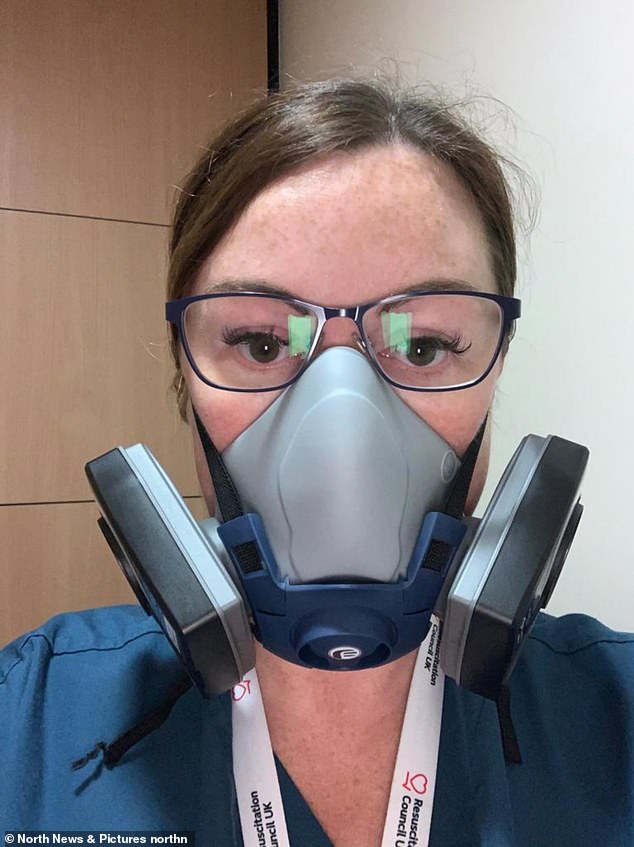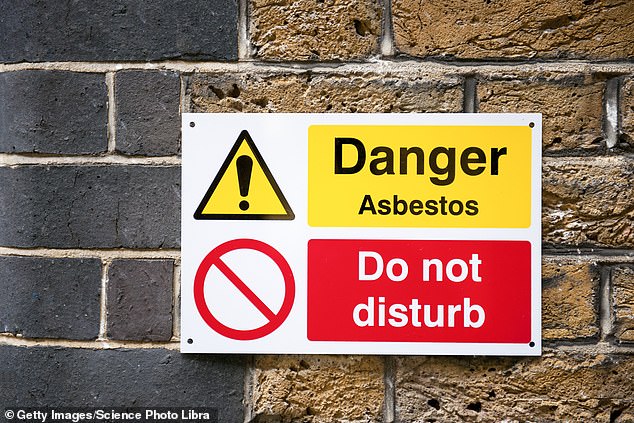Helen Bone is 42 years old and the mother of three young daughters. Three years ago she was diagnosed with mesothelioma, a type of lung cancer caused solely by exposure to asbestos.
As a nurse, Helen has spent her life in hospitals, all with asbestos, perhaps in ceilings, walls, floors, pipes, practically anywhere.
As a schoolgirl, she, like millions of us, would have been in buildings where there was also asbestos.
In the past, mesothelioma (and other asbestos-related diseases) was considered an “old workers’ disease” that only construction workers, miners and ship workers contracted. This is no longer the case.
We are now seeing the premature deaths of doctors, nurses and teachers who have worked in public buildings containing asbestos, and of thousands of other Britons who were exposed to it as schoolchildren. Helen is a typical example of this new category of patient.
Nurse Helen Bone, 42, with her daughters Livvy, 16, left, and Maddy, 13.
“I don’t know how long I’ll live,” he says, “but I do know that this is what will kill me.”
The average life expectancy for someone diagnosed with mesothelioma is between four and 18 months.
But despite her tragic circumstances, Helen says she is not angry: “I just want to see the government take action to eradicate asbestos so that no one else has to explain to their three young daughters that mummy won’t be here forever.”
July 5, the day after the general election, is Mesothelioma Action Day. Of course, the incoming government faces a difficult to-do list with competing priorities, from the economy and national security to the National Health System and migration.
But, like Helen, I would like to see this issue – ridding Britain of the scourge of asbestos – high on the public health agenda. Let me explain why.
Asbestos is a silent killer: odorless, tasteless and lethal.
In fact, it is responsible for the deaths of 20,000 people each year in Britain, making it the leading cause of occupational death in the country.
And yet 5.5 million buildings in the UK still contain this dangerous material.
I think this is the next big scandal—akin to the Post Office/Horizon scandal or the infected blood crisis—hiding in plain sight, with denial and institutional failure at its heart.
Why then have successive governments, over decades, done nowhere near enough to resolve this crisis? The answer, I fear, is a sordid tale of cover-ups, disinformation and ministerial mismanagement on an unprecedented scale.

Three years ago, Helen was diagnosed with mesothelioma, a type of lung cancer caused solely by exposure to asbestos.
The supposed safety of “untouched” asbestos in our schools, hospitals and social housing is the biggest lie in public life. A lie that has already claimed thousands of lives and will claim thousands more if action is not taken.
Asbestos is a naturally occurring mineral that was widely used between the 1950s and 1990s as a cheap insulator in the construction of most new buildings.
However, inhaling its microscopic fibers can cause lung cancer (including mesothelioma), as well as asbestosis, a painful inflammation and scarring of the lungs.
The use of brown asbestos was banned in Britain in 1985, and fourteen years later the use of the less dangerous white derivative was also banned. However, there has been no coordinated national effort to remove asbestos on site. In 2002 I founded a company called Lucion, a specialist asbestos consultancy dedicated to the careful monitoring and safe removal of the material.
By 2017, we were a world leader in risk management, advising on everything from legionella to radiation. But try as we might, we were unable to get policymakers to take much-needed legislative action on asbestos.
In 2019, I sold Lucion. My friends and family told me I was crazy. It was a company I had dedicated my life to and it had grown into a world-leading and highly profitable consulting firm.
But I could no longer remain silent. I now lead the Airtight on Asbestos campaign, which aims to put pressure on the government to radically overhaul the UK’s strategy for tackling the asbestos problem.
A report published in 2022 by the Department for Work and Pensions Select Committee cited 16 recommendations for asbestos management. I consider three of them to be essential and urgent: establishing a national asbestos database; developing a 40-year strategic plan to eradicate the risk of asbestos from UK infrastructure; and introducing effective air monitoring in areas where people are most at risk.

As a nurse, Helen has spent her life in hospitals, all with asbestos, perhaps in ceilings, walls, floors, pipes, practically anywhere.

Asbestos is a silent killer: odourless, tasteless and lethal. It is responsible for the deaths of 20,000 people in Britain each year, making it the country’s leading cause of occupational death.
These recommendations were backed by the Department for Work and Pensions and a coalition of 28 unions representing 4.5 million workers. However, the Health and Safety Executive (HSE) refused to support the measures and no action was taken.
The question then is: why, while France, Poland, the Netherlands and Australia are working frantically to save lives, is Britain lagging so dangerously behind?
The first problem is that mesothelioma has a latency period of up to 40 years. Of the tens of thousands of people who are diagnosed with asbestos-related diseases each year, their exposure dates back decades, making it very difficult to prove cause and effect. They have lived their lives unaware of the time bomb that was inside them.
The second problem is reporting of deaths. I have already told you that 20,000 people die each year in the UK from exposure to asbestos, but the HSE estimates that figure to be only 5,000 people – a radical underestimation that undermines the need for immediate action.
But who is right? The HSE reckons that around 2,000 people die from mesothelioma each year in the UK. The international standard is to assume that the ratio of mesothelioma deaths to deaths from other forms of asbestos-related cancer is 1:8. So a bit of basic maths gives my figure of 20,000.
However, the HSE refutes the international standard ratio and unilaterally uses its own 1:1 ratio, which produces its figure. Why does the HSE use its own, absolutely unfounded metric? I have asked their staff many times and have never received an answer.
The third and perhaps most important reason why asbestos is not taken seriously enough in this country is the myth, perpetuated by the HSE, that intact asbestos is “safe”.
I have studied asbestos for almost a quarter of a century. Let me tell you, there is no such thing as brown asbestos that is safe inside an occupied building.
Asbestos is incredibly friable. It only takes a small amount of time to disturb the material and release deadly microscopic fibres into the atmosphere. Bad weather, a child slamming a classroom door or simply a ball thrown against a wall are all enough to release thousands of fibres into ventilation ducts and eventually into classrooms.
And let’s not forget that buildings containing asbestos (whether a hospital or a school) were designed in the 1960s and 1970s to last about 40 years. They are now subject to almost constant maintenance. Every time contractors carry out work, they inadvertently disturb the asbestos in the building. It’s impossible not to.
HSE policy states that 0.1 asbestos fibres per millilitre in air is the safe limit.
But what if I told you that 0.1 fibers per milliliter equals 8 fibers per breath, 10,000 fibers inhaled per hour, and 60,000 fibers in a school day per child? Does that sound safe to you?
As a father of three, these numbers make me furious.
Even more shocking is that the HSE’s own research puts the safe limit at 0.0001, considerably lower than the current figure.
Why is there such a discrepancy between HSE scientists’ advice and their official policy?
I’m afraid it all comes down to a question of accountability. Over its nearly 50 years of existence, the HSE has failed the British public dismally on the issue of asbestos.
This is the biggest national scandal of our lifetimes, but no one, from the HSE to Downing Street, wants to admit it because the responsibilities will be too great – both financially and professionally – for those who have failed to act.
Ironically, a recent cost-benefit analysis estimates that the long-term cost to the government will be three times higher if it does not tackle the problem head-on. Unfortunately, no government has ever been willing to take a long-term view.
The reality is that we have the technology and the know-how to stop this madness. All we need now is the political will to minimise the risks and safeguard the lives of millions of our children and young people.
A national database, an air monitoring system, and a strategic plan to eliminate asbestos from our built environment—starting with the buildings where the risk is greatest—are basic common sense.
Dare I hope that a new government will listen and finally take a common-sense approach to what will otherwise be a very costly disaster for the public purse and cost many more lives in the future?
It doesn’t seem like too much to ask, does it? Making Helen Bone’s wish come true?


